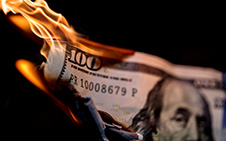 A United States Department of Agriculture briefing paper on Unmanned Aircraft Systems aerial ignition operations has found that using a drone for prescribed burning costs approximately $1,800 a day compared to the $16,000 a day for a type lll Call-When-Needed helicopter.
A United States Department of Agriculture briefing paper on Unmanned Aircraft Systems aerial ignition operations has found that using a drone for prescribed burning costs approximately $1,800 a day compared to the $16,000 a day for a type lll Call-When-Needed helicopter.
The USDA Forest Service, Southern Region, carried out aerial ignition missions in the spring using the Matrice 600 Pro aircraft with Drone Amplified, IGNIS 2 aerial ignition payload. In all, 15,226 acres were treated in 11 forests across six states taking up approximately 50 flight hours.
Over 40,000 spheres were dropped during the four week-project with total flight times ranging from 47 minutes (129 acres) to roughly 4 hours (2,412 acres).
“We were delighted to be involved in what was a comprehensive field survey of the capabilities and unique advantages UAS bring to prescribed burnings and how they can complement firefighters on the ground and manned aircraft, while increasing safety,” said Drone Amplified founder Carrick Detweiler.
Among the key findings of the operations were:
Operational Functionality: UAS firing patterns, communications and ignition time frames were similar to helicopter ignitions. However, the Firing Boss (FIRB) is in a less stressful atmosphere on the ground with the UAS pilot, rather than flying in a helicopter front seat.
Firing Patterns: “Smoking Out” is a non-issue due to thermal imagery.
Ignition Sphere Spacing: IGNIS 2 can dial in the drop spacing in real time, helping the FIRB balance fire behavior and burn objectives.
Summertime Growing Season: Common feedback from the field concluded that UAS would be highly beneficial for growing season burns, especially in southern rough and coastal fuel types, when exposure and fatigue are increased for firefighters on the ground due to heat and vegetation.
The USDA has now put in place a Regional UAS Coordinator to work with both Regional and National aviation leadership to establish and develop the Forest Service UAS program and to coordinate logistics, training, aviation safety plans and directing UAS modules within Region 8.
